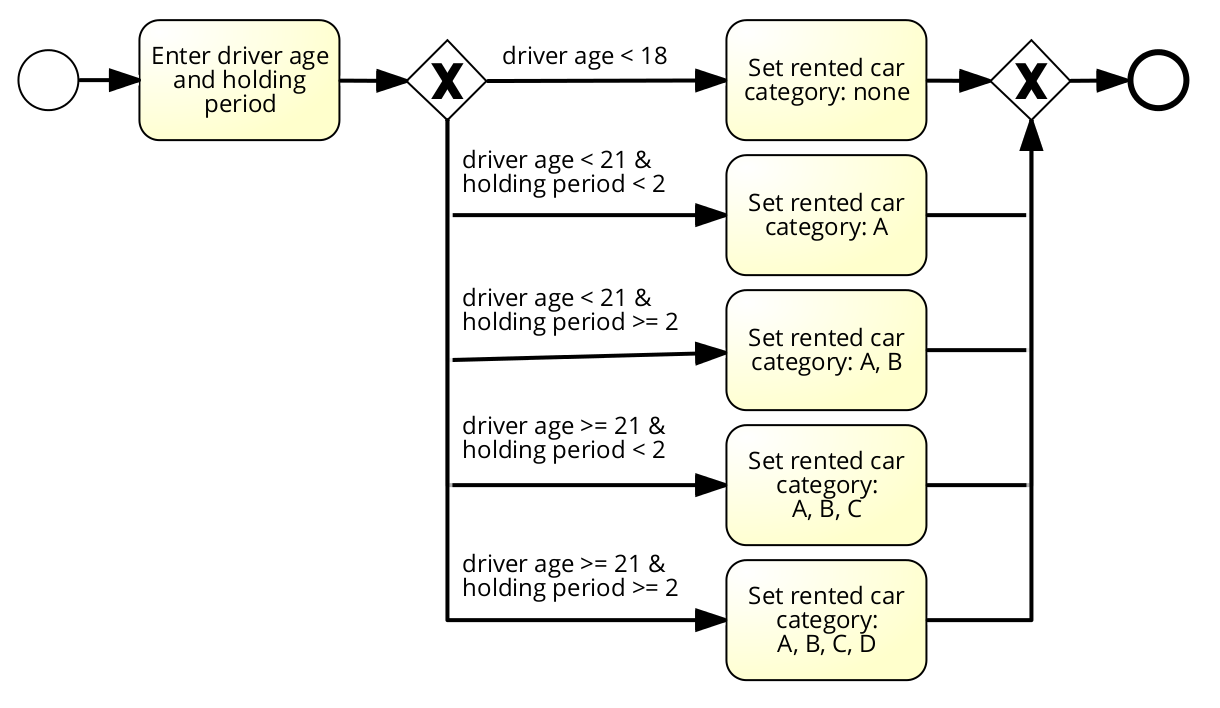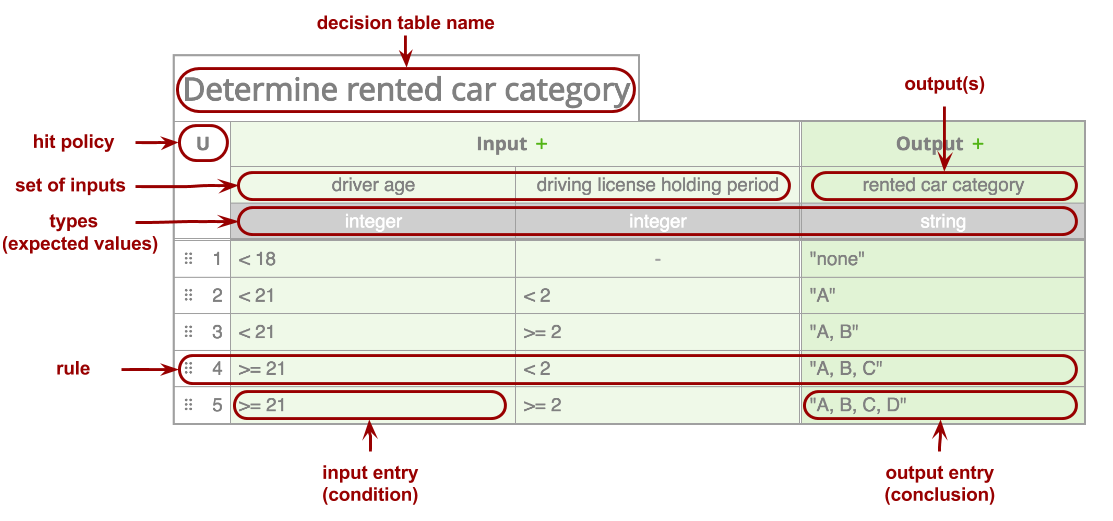Manual rules modeling
Rules can constitute a useful knowledge representation for low-level logic in process tasks.
During this tutorial, we will try to create decision tables which can model decision logic in business processes.
For this purpose, we will use Decision Model and Notation (DMN).
Short example with DMN model
Business rules can be represented in various ways, the most popular ones are just sets of production rules ('if … then …'). Such sets can be also represented in a more compact way using decision trees or decision tables. Look at the following example of determining a rented car category for a customer. The rented car category corresponds to Euro Car Segment classification, and it is based on the driver age and driving license holding period:
If driver age is below 18,
then driver can not rent a car.
If driver age is below 21
and driving license holding period is below 2,
then driver can only rent a car of rented car category A.
If driver age is below 21
and driving license holding period is above or equal 2,
then driver can rent a car of rented car category A or B.
If driver age is at least 21
and driving license holding period is below 2,
then driver can rent a car of rented car category A, B, or C.
If driver age is at least 21
and driving license holding period is at least 2,
then driver can rent a car of rented car category A, B, C, or D.
The presented rule set is described in natural language. But there are ways to formalize such description using e.g., Attributive Logic. In such case, some concepts would become attributes and some of them will be values from their domains.
Some operators can be interchangeable, e.g., is above or equal and is at least.
Rule set in pure BPMN model
In BPMN, we could represent these rules in the following way:

However, this is not a good way of modeling processes. Maintaining such a model is a hard task and its complexity is very high.
A much better solution is to use DMN for this purpose. Then, our BPMN and DMN models will look as follows (the notations are grouped in the diagram for the explanation, and these rectangles are not a part of these notations):

This simple DMN model consists of 2 various elements: Decisions and Input Data. The arrows indicate which input data will be considered as an input for the decision.
Rule set in pure DMN model
The same rules as in the previous example, we can model using DMN specification in the following decision table:

Such a decision table consists of the following elements:

Testing DMN model using Camunda simulator
Exercise
Using any of the available DMN tools prepare the decision table for the example described above:
Short tutorials for DMN you can find on:
Group Assignment
Till now you have a broad knowledge of business process modeling. Classes 14.12.2020 and 21.12.2020 are dedicated to preparing integrated models of business processes and business decisions. When modeling, take into account best practices we talked about during the lectures.
During the classes on 14.12.2020, you should get to know how to model business decision models in the DMN notation.
During the classes on 14.12.2020 and 21.12.2020, your goal is to prepare a BPMN model depicting some fragment of the process of admission to the AGH University of Science and Technology integrated with a DMN model that specifies at least one decision table. During this and next lab classes, you can discuss the issues concerning BPMN and DMN modeling within your groups and consult your models.
Report
As this is the last report, and I would like to check all your reports during the winter break, so you could get to know your grades at the beginning of January, the official deadline for the report 22.12.2020.
The short report from these two classes is required. The report should consist of:
PDF report with diagrams and a short description of the presented model and sources of information for the models, and
the XML file of the model.
The process of admission to the AGH University of Science and Technology is described in documents on the website:
https://www.international.agh.edu.pl/eng/regular-studies/admission/
Model the processes in a group so that you could share your insight with group members.
As the whole procedure is large, do not model all the details, focus on the most important parts of the process or some subprocess (remember to justify it in the report). When modeling, you should follow best practices and guidelines for modeling process and decision models. Remember about the possibility of splitting it into subprocesses (decomposing models).
Although you can use any process modeling tool for this exercise, it is recommended to use the academic version of Signavio Process Editor as you can model there both BPMN and DMN models.




